
The front bumper is looking lost all by itself on the floor.
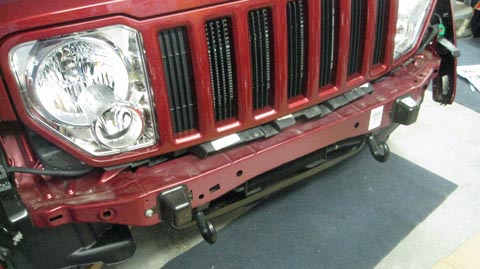
The front of my car looks naked, but is open and accessible for the installation.


These brackets are very securely bolted to the frame in multiiple places. There are inserts that slide into these and then twist to securely
lock them into place. There is a cross bar that fits to these inserts and provides the attachment for the towbar.
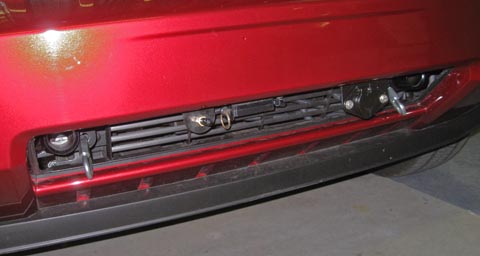
After replacing the bumper, I mounted several accessories to complete the installation.
Looking from left to right we have the towbar bracket mount, the safety cable attachment
ring, the air fitting that connects the brakes, the breakaway switch (folded in for driving - it
swings out for towing), the electrical connector, the other cable ring, and the other towbar
bracket mount.
Since the bumper ledge where most of these items mount is just plastic, I placed
a bar of aluminum above the ledge. All the bolt-on items thread directly into the bar.
It makes it very rigid. When the car is not set up for towing, the additions are
almost invisible to the casual observer from a normal eye level. They show well
in this picture as it was taken from a very low angle
Brake
Installation
The braking system I installed in the Subaru consists of a motorhome and a car system. The motorhome has a of a tank, valves, and an air brake relay triggered by the air brakes. It is designed to send a pressure that is proportional to the braking pressure, while maintaining the safety of the system. If the line to the car were to break, there would be no loss of braking for the motorhome (other than the loss of the car brakes to assist). No other brand of tow brake has this feature.
The car portion of this system consists of a control box and an air cylinder that actually pulls the brake pedal downward. The control box has a special venturi which creates a vacuum to activate the power brakes, an air storage tank for the breakaway system, and some control valves and solenoids. It activates the brake pedal air cylinder. If the pin should be pulled from the breakaway switch, such as if the towbar were to fail, the brakes are automatically applied to the car to quickly bring it to a stop. This installation was written up in much more detail in the Motorhome Projects section. Please CLICK HERE to see that writeup. The same writeup is linked to the item (Adding a Tow Brake System to my Cars) above this one on the MY CAR MODS page.
The braking system I installed in the Subaru consists of a motorhome and a car system. The motorhome has a of a tank, valves, and an air brake relay triggered by the air brakes. It is designed to send a pressure that is proportional to the braking pressure, while maintaining the safety of the system. If the line to the car were to break, there would be no loss of braking for the motorhome (other than the loss of the car brakes to assist). No other brand of tow brake has this feature.
The car portion of this system consists of a control box and an air cylinder that actually pulls the brake pedal downward. The control box has a special venturi which creates a vacuum to activate the power brakes, an air storage tank for the breakaway system, and some control valves and solenoids. It activates the brake pedal air cylinder. If the pin should be pulled from the breakaway switch, such as if the towbar were to fail, the brakes are automatically applied to the car to quickly bring it to a stop. This installation was written up in much more detail in the Motorhome Projects section. Please CLICK HERE to see that writeup. The same writeup is linked to the item (Adding a Tow Brake System to my Cars) above this one on the MY CAR MODS page.
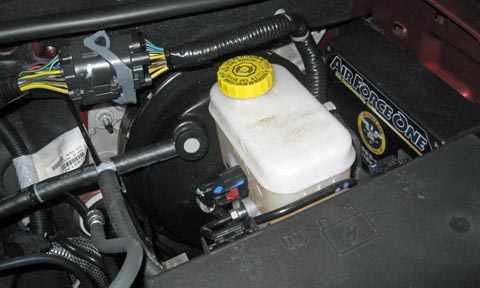
I removed the SMI Air Force One tow car braking system from the Subaru and
mounted it in the Jeep.
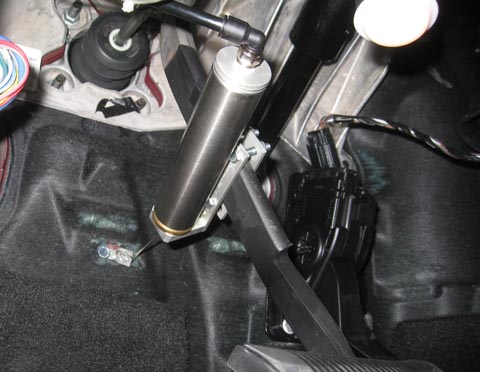
The air cylinder mounts in the Jeep much more easily than it did in the Subaru,
as there is no clutch pedal to interfere.
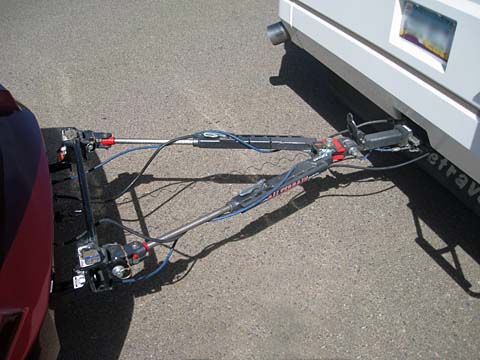
The car is hooked to the motorhome with all the safety cables, brake connections,
and electrical connections.
Tow
Light Wiring.
As part of this project, I needed to connect the stop lights to the connector under the front bumper such that they work as both stop lights and turn signals. I started to add separate sockets to house a pair of dedicated bulbs for this function as recommended by several reputable sources. Upon looking at the geometry where the new bulbs would be, I realized they would be far from the focal point of the reflector, and would therefore loose much of the apparent brightness. I then re-thought my design and installed diodes the same as I have always done on previous cars. The diodes prevent the power from the motorhome from feeding back into the other car systems and vise-versa. The end results were excellent.
The brake system manufacturer supplied an LED array to place on the front bumper of the car. These lights would light up with the brake lights on the car. The driver was supposed to be able to see these lights in the backup camera and know that the brakes were applied. I didn't care for that! Instead, I wired an extra terminal in the connector to the brake lights on the car, connected that pin on the motorhome to a wire running to the front and from there to an LED on the dashboard. Now I can verify that the car brakes are working by noting the small light come on.
As part of this project, I needed to connect the stop lights to the connector under the front bumper such that they work as both stop lights and turn signals. I started to add separate sockets to house a pair of dedicated bulbs for this function as recommended by several reputable sources. Upon looking at the geometry where the new bulbs would be, I realized they would be far from the focal point of the reflector, and would therefore loose much of the apparent brightness. I then re-thought my design and installed diodes the same as I have always done on previous cars. The diodes prevent the power from the motorhome from feeding back into the other car systems and vise-versa. The end results were excellent.
The brake system manufacturer supplied an LED array to place on the front bumper of the car. These lights would light up with the brake lights on the car. The driver was supposed to be able to see these lights in the backup camera and know that the brakes were applied. I didn't care for that! Instead, I wired an extra terminal in the connector to the brake lights on the car, connected that pin on the motorhome to a wire running to the front and from there to an LED on the dashboard. Now I can verify that the car brakes are working by noting the small light come on.
<BACK>
R. S. Mason
6/24/14